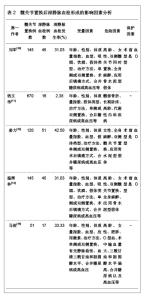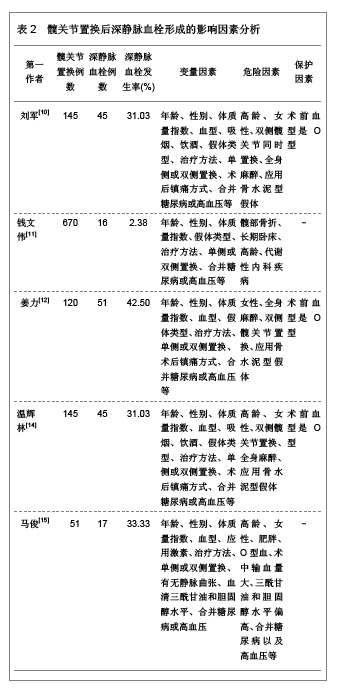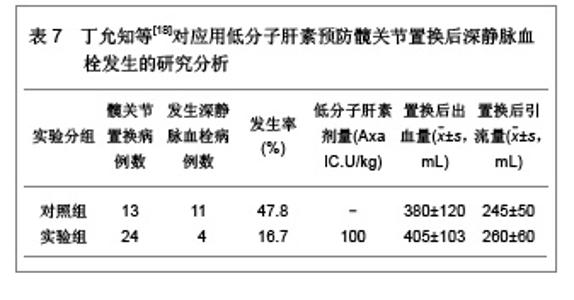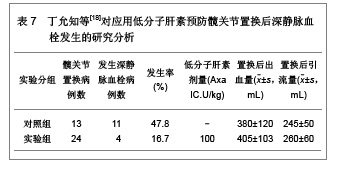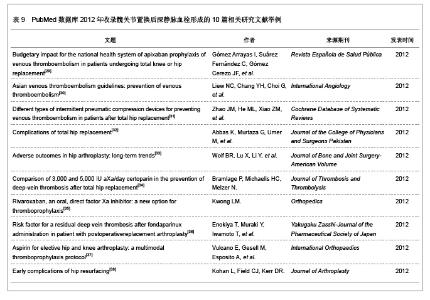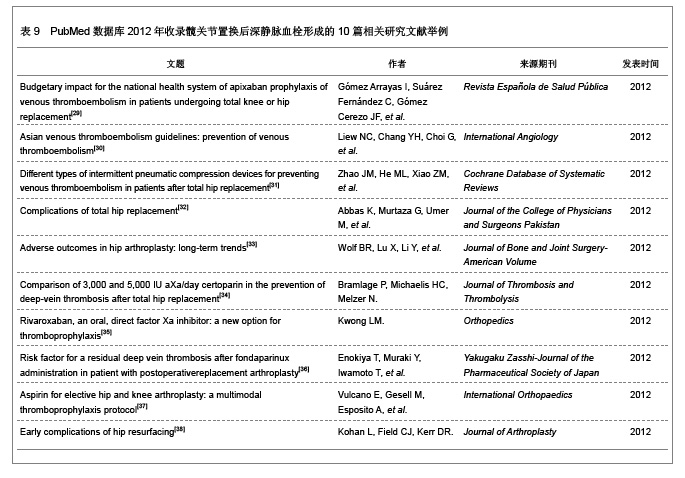Chinese Journal of Tissue Engineering Research ›› 2013, Vol. 17 ›› Issue (4): 720-727.doi: 10.3969/j.issn.2095-4344.2013.04.024
Previous Articles Next Articles
Deep vein thrombosis after hip replacement
Yan Gu-ning, He Liang-liang
- The Second Department of Orthopedics, Guyuan Provincial People’s Hospital, Guyuan 756000, Ningxia Hui Autonomous Region, China
-
Received:2012-10-18Revised:2012-11-27Online:2013-01-22Published:2013-01-22 -
About author:Yan Gu-ning, Associate chief physician, the Second Department of Orthopedics, Guyuan Provincial People’s Hospital, Guyuan 756000, Ningxia Hui Autonomous Region, China ccmue@126.com
CLC Number:
Cite this article
Yan Gu-ning, He Liang-liang. Deep vein thrombosis after hip replacement[J]. Chinese Journal of Tissue Engineering Research, 2013, 17(4): 720-727.
share this article

通过对影响髋关节置换后深静脉血栓形成的变量因素进行分析,其中包括性别、年龄、体质量指数、各种生化代谢指标、髋关节置换时采用的治疗方法等进行综合分析,发现高龄,一般为年龄≥65岁,女性,肥胖,双侧髋关节同时置换,治疗时采用全身麻醉,应用骨水泥型假体均可以增加深静脉血栓发生的风险,另外,长期卧床,合并高血压、糖尿病、心脏病、脑血管疾病以及肾脏疾病等也可以增加深静脉血栓发生的风险,而对于患者术前为O型血的因素,研究显示其影响结果不定,多数研究显示患者术前为O型血可以降低髋关节置换后深静脉血栓形成的风险,但也有研究显示患者术前为O型血可能增加髋关节置换后深静脉血栓形成的风险。 2.2 髋关节置换后深静脉血栓形成与细胞因子表达的相关性 髋关节置换后深静脉血栓的发生与各种炎性细胞因子的参与密切相关,李春杰等[17]和马骊等[16]分别对影响深静脉血栓形成的炎性细胞因子进行了研究分析,具体实验方法和结果见表3-5。"

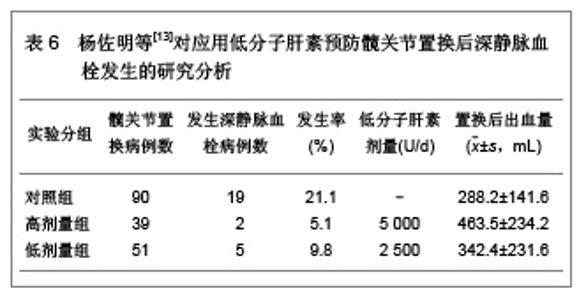
上述2组实验均对对照组即未发生血栓患者和实验组发生血栓患者治疗前后炎性细胞因子的变化进行了对比分析,结果显示发生深静脉血栓患者的炎性细胞因子的表达水平明显高于未发生深静脉血栓的患者。 可能的原因为:髋关节置换过程中创伤的刺激,使全髋关节置换患者处于应激状态,大量内毒素进入血液循环,体内巨噬细胞和单核细胞活化,释放肿瘤坏死因子α、白细胞介素1、白细胞介素6以及白细胞介素10等炎性细胞因子,这些炎性细胞因子在深静脉血栓形成和发展的过程中发挥着重要的作用。炎性细胞因子诱导细胞黏附分子的产生,细胞黏附分子在血管内皮细胞表面表达后促使白细胞在血管壁的黏附。炎性细胞因子和细胞黏附分子的表达不仅是血管内皮损伤的标志,而且还加剧了血管内皮细胞的损伤。 2.3 应用低分子肝素预防髋关节置换后深静脉血栓的形成 杨佐明等[13]和丁允知等[18]对应用低分子肝素后髋关节置换后深静脉血栓的发生比例进行了研究分析,具体实验方法和结果见表6和表7。"
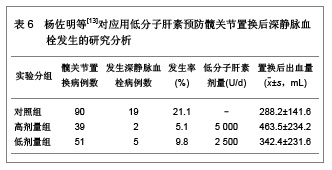
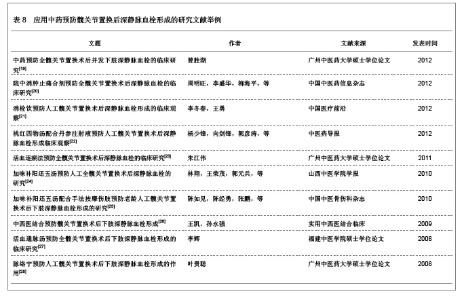
低分子肝素是1980年由Holmen首先报道的,其相对分子质量为4 000-6 500,能够特异性地与抗凝血酶Ⅲ结合,不受血浆蛋白的影响,低分子肝素是通过化学方法由普通肝素解聚而获得,低剂量的低分子肝素即可以发挥较强的抗凝活性作用。并且半衰期较长,为普通肝素的2-4倍。与普通肝素相比,其应用时抑制血小板的功能降低,微血管的通透性增加较少,与血浆蛋白、血管内皮细胞和血细胞结合减少,出血的不良反应发生减少,安全性增高,生物利用率高达90%以上,是髋关节置换后深静脉血栓形成的首选预防药物。杨佐明等[13]和丁允知等[18]的实验研究均显示应用低分子肝素可以明显降低深静脉血栓的发生率,能够有效预防人工髋关节置换后深静脉血栓的形成。 2.4 应用中药预防髋关节置换后深静脉血栓的形成 髋关节置换后深静脉血栓形成的预防药物主要是抗凝溶栓类药物,其中包括华法林、肝素等西医类药物,也包括丹参、桃红四物汤、加味补阳还五汤、活血通脉汤以及脉络宁等很多中医类药物,均有很好的血栓防治效果,举例10篇应用中药预防髋关节置换后深静脉血栓形成的研究文献,见表8。 2.5 PubMed数据库2012年收录髋关节置换后深静脉血栓形成的10篇相关研究文献举例 见表9。"
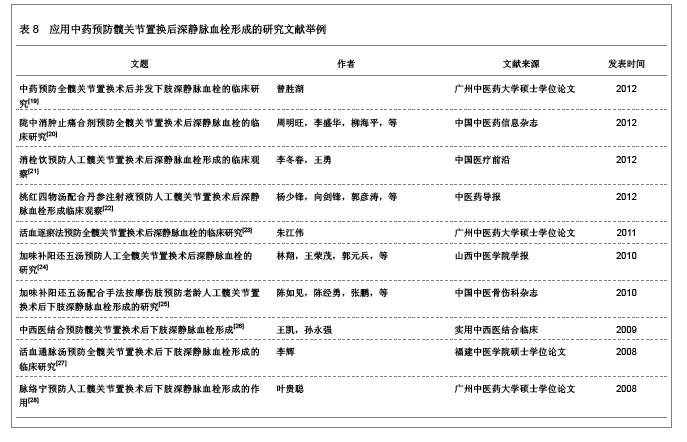
| [1] Lonner JH, Frank J, McGuire K, et al. Postthrombotic syndrome after asymptomatic deep vein thrombosis following total knee and hip arthroplasty. Am J Orthop (Belle Mead NJ). 2006;35(10):469-472. [2] Clarke MT, Green JS, Harper WM, et al. Screening for deep-venous thrombosis after hip and knee replacement without prophylaxis. J Bone Joint Surg Br. 1997;79(5): 787-791. [3] Westrich GH, Sculco TP. Prophylaxis against venous thromboembolic disease: costs and controversy. J Bone Joint Surg Am. 2002;84-A(12):2306-2307. [4] 邱贵兴,杨庆铭,余楠生,等.低分子肝素预防髋、膝关节手术后下肢深静脉血栓形成的多中心研究[J].中华骨科杂志,2006,26(12): 819-822.[5] Esmon CT. Basic mechanisms and pathogenesis of venous thrombosis. Blood Rev. 2009;23(5):225-229. [6] 查振刚,臧学慧,姚平,等.全髋关节置换术后深静脉血栓形成的临床研究及危险因素分析[J].中华外科杂志,2005,43(8):511-512.[7] 张维蛟,王东生,孙红辉,等.老年患者全髋关节置换术后深静脉血栓的联合预防(附45例分析)[J].吉林医学,2008,29(19): 1647-1648.[8] 杨景武,史晓林.人工全髋关节置换术后下肢深静脉血栓形成原因的实验观察[J].中国临床康复,2005,9(42):164-166.[9] 中国知网.中国学术期刊总库[DB/OL].2012-12-2. https://www.cnki.net[10] 刘军,沈飞,黄际河.全髋关节置换术后深静脉血栓形成的危险因素分析[J].昆明医科大学学报,2012,33(7):84-87.[11] 钱文伟,翁习生,常晓,等.人工髋关节置换后深静脉血栓形成影响因素的回顾分析[J].中骨组织工程研究,2012,16(4):622-625.[12] 姜力.老年髋关节置换术后深静脉血栓形成的发生率及危险因素分析[J].医药论坛杂志,2011,32(16):17-19.[13] 杨佐明,刘晓明,戴士峰,等.低分子肝素预防人工全髋关节置换术后深静脉血栓疗效观察[J].中国修复重建外科杂志,2010,24(9): 1058-1061.[14] 温辉林,王友华,顾永强,等.全髋关节置换术后深静脉血栓形成的危险因素分析[J].江苏医药,2009,35(2):145-147.[15] 马俊,沈彬,杨静,等.人工全髋关节置换术后下肢深静脉血栓形成的危险因素分析[J].中国矫形外科杂志,2009,17(13):965-969.[16] 马骊,任凤霞,张林.全髋关节置换后血清炎性因子表达及深静脉血栓形成57例分析[J].中国组织工程研究与临床康复,2009, 13(4):771-773.[17] 李春杰,芦皓,文军,等.全髋关节置换者深静脉血栓形成早期血浆细胞因子及细胞间黏附分子的变化[J].中国组织工程研究与临床康复,2008,12(4):639-642.[18] 丁允知,刘晓钟.低分子肝素预防人工全髋关节置换术后下肢深静脉血栓形成的研究[J].海南医学,2008,19(10):82-83.[19] 曾胜湖.中药预防全髋关节置换术后并发下肢深静脉血栓的临床研究[D].广东:广州中医药大学,2012:1-45.[20] 周明旺,李盛华,柳海平,等.陇中消肿止痛合剂预防全髋关节置换术后深静脉血栓的临床研究[J].中国中医药信息杂志,2012, 19(3): 13-15. [21] 李冬春,王勇.消栓饮预防人工髋关节置换术后深静脉血栓形成的临床观察[J].中国医疗前沿,2012,7(4):41,54. [22] 杨少锋,向剑锋,郭彦涛,等.桃红四物汤配合丹参注射液预防人工髋关节置换术后深静脉血栓形成临床观察[J].中医药导报,2012, 18(9):28-30.[23] 朱江伟.活血逐瘀法预防全髋关节置换术后深静脉血栓的临床研究[D].广东:广州中医药大学,2011:1-42.[24] 林翔,王荣茂,郭元兵,等.加味补阳还五汤预防人工全髋关节置换术后深静脉血栓的研究[J].山西中医学院学报,2010,11(2):26- 27. [25] 陈如见,陈经勇,张鹏,等.加味补阳还五汤配合手法按摩伤肢预防老龄人工髋关节置换术后下肢深静脉血栓形成的研究[J].中国中医骨伤科杂志,2010,(1):29-31.[26] 王凯,孙永强.中西医结合预防髋关节置换术后下肢深静脉血栓形成[J].实用中西医结合临床,2009,9(2):33-34.[27] 李辉.活血通脉汤预防全髋关节置换术后下肢深静脉血栓形成的临床研究[D].福建:福建中医学院,2008:1-32. [28] 叶贵聪.脉络宁预防人工髋关节置换术后下肢深静脉血栓形成的作用[D].广东:广州中医药大学,2008:1-28.[29] Gómez Arrayas I, Suárez Fernández C, Gómez Cerezo JF, et al. Budgetary impact for the national health system of apixaban prophylaxis of venous thromboembolism in patients undergoing total knee or hip replacement. Rev Esp Salud Publica. 2012;86(6):601-612.[30] Liew NC, Chang YH, Choi G, et al. Asian venous thromboembolism guidelines: prevention of venous thromboembolism. Int Angiol. 2012;31(6):501-516.[31] Zhao JM, He ML, Xiao ZM, et al. Different types of intermittent pneumatic compression devices for preventing venous thromboembolism in patients after total hip replacement. Cochrane Database Syst Rev. 2012. [32] Abbas K, Murtaza G, Umer M, et al. Complications of total hip replacement. J Coll Physicians Surg Pak. 2012;22(9): 575-578. [33] Wolf BR, Lu X, Li Y, et al. Adverse outcomes in hip arthroplasty: long-term trends. J Bone Joint Surg Am. 2012; 94(14):e103. [34] Bramlage P, Michaelis HC, Melzer N. Comparison of 3,000 and 5,000 IU aXa/day certoparin in the prevention of deep-vein thrombosis after total hip replacement. Thromb J. 2012;10(1):10. [35] Kwong LM. Rivaroxaban, an oral, direct factor Xa inhibitor: a new option for thromboprophylaxis. Orthopedics. 2012;35(6): e932-8;discussion e939. [36] Enokiya T, Muraki Y, Iwamoto T, et al. Risk factor for a residual deep vein thrombosis after fondaparinux administration in patient with postoperativereplacement arthroplasty. Yakugaku Zasshi. 2012;132(5):683-687.[37] Vulcano E, Gesell M, Esposito A, et al. Aspirin for elective hip and knee arthroplasty: a multimodal thromboprophylaxis protocol. Int Orthop. 2012;36(10):1995-2002. [38] Kohan L, Field CJ, Kerr DR. Early complications of hip resurfacing. J Arthroplasty. 2012;27(6):997-1002. [39] 张玥,刘效敏,张玉冬.深静脉血栓形成患者血清TNF-α、IL-6、IL-10水平变化及意义[J].放射免疫学杂志,2007,20(1):13-14.[40] Salvati EA, Della Valle AG, Westrich GH, et al. The John Charnley Award: heritable thrombophilia and development of thromboembolic disease after total hip arthroplasty. Clin Orthop Relat Res. 2005;441:40-55. [41] Senaran H, Acaro?lu E, Ozdemir HM, et al. Enoxaparin and heparin comparison of deep vein thrombosis prophylaxis in total hip replacement patients. Arch Orthop Trauma Surg. 2006;126(1):1-5. [42] Berend KR, Lombardi AV Jr. Multimodal venous thromboembolic disease prevention for patients undergoing primary or revision total joint arthroplasty: the role of aspirin. Am J Orthop (Belle Mead NJ). 2006;35(1):24-29. [43] 孟华,姜玉新.孤立性小腿深静脉血栓的超声诊断[J].中国医学影像技术,2002,18(9):919-921.[44] 关振鹏,吕厚山,陈彦章,等.影响人工关节置换术后下肢深静脉血栓形成的临床风险因素分析[J].中华外科杂志,2005,43(20): 1317-1320.[45] 查长松,赵玉华.彩色多普勒血流显像诊断下肢深静脉血栓[J].中国医学影像学杂志,1999,7(1):45-47.[46] Cronan JJ, Dorfman GS, Scola FH, et al. Deep venous thrombosis: US assessment using vein compression. Radiology. 1987;162(1 Pt 1):191-194.[47] Baxter GM, McKechnie S, Duffy P. Colour Doppler ultrasound in deep venous thrombosis: a comparison with venography. Clin Radiol. 1990;42(1):32-36. [48] Perrier A. Diagnostic strategies of thrombo-embolic venous disease. Rev Prat. 2003;53(1):35-41.[49] 秦琍.彩超在下肢深静脉血栓诊治中的应用[J].江苏医药,2005, 31(11):867.[50] 沈洲,徐福祥,樊盛军,等.低分子肝素对于人工全髋关节置换术后下肢深静脉血栓形成的预防[J].中国现代医药杂志,2007,9(2): 74-76.[51] Warwick D, Friedman RJ, Agnelli G, et al. Insufficient duration of venous thromboembolism prophylaxis after total hip or knee replacement when compared with the time course of thromboembolic events: findings from the Global Orthopaedic Registry. J Bone Joint Surg Br. 2007;89(6):799-807. [52] 王琦,张先龙,沈骏,等.“低风险”人群初次人工关节置换术后的深静脉血栓[J].中华骨科杂志,2007,27(2):106-109.[53] Schindler OS, Dalziel R. Post-thrombotic syndrome after total hip or knee arthroplasty: incidence in patients with asymptomatic deep venous thrombosis. J Orthop Surg (Hong Kong). 2005;13(2):113-119. |
| [1] | Chen Ziyang, Pu Rui, Deng Shuang, Yuan Lingyan. Regulatory effect of exosomes on exercise-mediated insulin resistance diseases [J]. Chinese Journal of Tissue Engineering Research, 2021, 25(25): 4089-4094. |
| [2] | Bi Qingwei, Liu Chengpu, Li Yan, Zhao Wenwen, Han Mei. Structure analysis of platelet-rich fibrin derived from two centrifugation procedures [J]. Chinese Journal of Tissue Engineering Research, 2021, 25(22): 3534-3539. |
| [3] | Jiang Shengyuan, Li Dan, Jiang Jianhao, Shang-you Yang, Yang Shuye. Biological response of Co2+ to preosteoblasts during aseptic loosening of the prosthesis [J]. Chinese Journal of Tissue Engineering Research, 2021, 25(21): 3292-3299. |
| [4] | Lin Haishan, Mieralimu Muertizha, Li Peng, Ma Chao, Wang Li. Correlation between skeletal muscle fiber characteristics and bone mineral density in postmenopausal women with hip fractures [J]. Chinese Journal of Tissue Engineering Research, 2021, 25(20): 3144-3149. |
| [5] | Jing Jinpeng, Zhang Yue, Liu Xiaomin, Liu Yi. Buyang Huanwu Decoction in prevention of deep venous thrombosis after orthopedic surgery: meta-analysis and trial sequential analysis [J]. Chinese Journal of Tissue Engineering Research, 2021, 25(20): 3267-3274. |
| [6] | Tian Lin, Shi Xiaoqing, Duan Zhenglan, Wang Kuan, Zhang Li, Wang Peimin. Efficacy and safety of transverse tibial bone transport technique in the treatment of diabetic foot:a meta-analysis#br# [J]. Chinese Journal of Tissue Engineering Research, 2021, 25(20): 3275-3280. |
| [7] | Li Songtao, Li Xinyi, Song Yunfeng, Ning Jiayin, Ren Qiang, Yang Renxu, Peng Bo. Maxing Xiongting Mixture regulates factors relevant to lung reshaping and vascular remodeling of hypoxic pulmonary hypertension rats [J]. Chinese Journal of Tissue Engineering Research, 2021, 25(2): 274-280. |
| [8] | Chen Xinling, Wang Shenglan. Cell autophagy, pathway, regulation and its multiple correlations with pulmonary hypertension [J]. Chinese Journal of Tissue Engineering Research, 2021, 25(2): 311-316. |
| [9] | Xia Wenshen, He Renjiao, Ai Jinwei, Wang Jun, Li Desheng, Pei Bin. Stem cell transplantation for diabetic patients with lower-extremity arterial disease: a meta-analysis [J]. Chinese Journal of Tissue Engineering Research, 2021, 25(19): 3110-3116. |
| [10] | Chen Deng, Zhang Yaxin, Dai Jihang, Chen Duoyun, Sun Yu. Analysis on relative factors affecting pyrexia following total hip replacement [J]. Chinese Journal of Tissue Engineering Research, 2021, 25(18): 2846-2850. |
| [11] | Luo Yicai, Li Hao. Effect of enhanced aryl hydrocarbon receptor expression on inflammatory response and healing of alveolar bone defects in diabetic rats [J]. Chinese Journal of Tissue Engineering Research, 2021, 25(14): 2166-2171. |
| [12] | Liu Yongyu, Xu Jingli, Lin Tianye, Wu Feng, Shen Chulong, Xiong Binglang, Zou Qizhao, Lai Qizhong, Zhang Qingwen . Sensitivity and specificity of D-dimer in the diagnosis of chronic periprosthetic infection after hip replacement [J]. Chinese Journal of Tissue Engineering Research, 2021, 25(12): 1853-1857. |
| [13] | Ye Quanying, Chen Qisheng, Li Yanwen, Wang Ting, Chen Xiaoyan, Yue Yun. Effect of cassia seed aqueous extract on blood pressure level in N-nitro-L-arginine-methyl ester induced hypertensive rats [J]. Chinese Journal of Tissue Engineering Research, 2021, 25(11): 1705-1711. |
| [14] | Guo Xuan, Xie Jun, Suo Jinrong, Li Yingrui, Huang Lei, Ma Munan, Li Jingjing, Fu Songtao. Transplantation of islet-like cells induced by human umbilical cord mesenchymal stem cells via different ways for the treatment of type 1 diabetic mice [J]. Chinese Journal of Tissue Engineering Research, 2021, 25(1): 78-83. |
| [15] | Ma Zhigang, Guo Liping, Zhang Jianning, Li Yonggang. Changes in related factors in synovial fluid of osteoarthritis rabbits after treatment with different molecular weights of sodium hyaluronate injection [J]. Chinese Journal of Tissue Engineering Research, 2020, 24(5): 694-698. |
| Viewed | ||||||
|
Full text |
|
|||||
|
Abstract |
|
|||||
